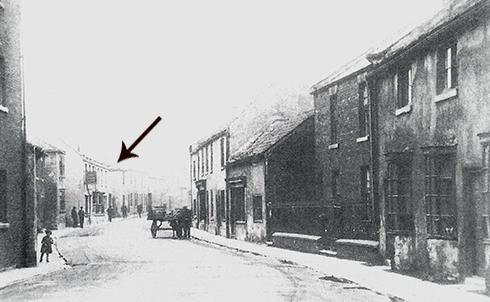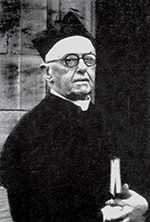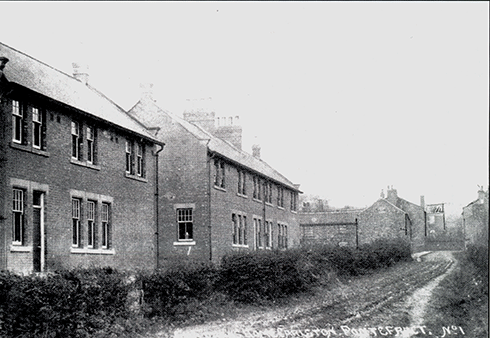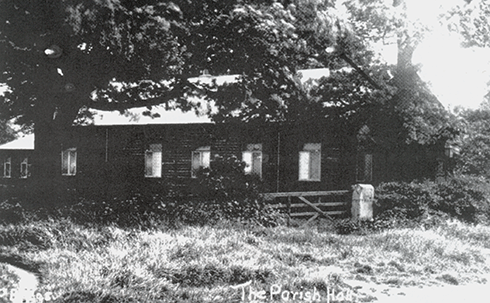Introduction
I was born on the 5th April in 1931, the second child of Alice Briggs who lived on Doncaster Road, Ferrybridge. It must have been a virgin birth because on my birth certificate, my mothers name is Alice Briggs and the fathers name column is blank? I have never known my fathers name. I suppose you can choose your friends but not your maker!
We were a very poor family, you could call it poverty because up to being four years old all I can remember is eating bread and lard or bread and sugar sandwiches. My playground was the A1 Edinburgh to London road which ran past our front door. No wonder I finished up as a lorry driver and later a HGV Instructor/Examiner.
A paraffin lamp was our only light and I used to accompany my older sister Mary to bring the paraffin from Amery’s Hardware Store in Ferrybridge Square when I was old enough, the square had a gas light in the middle which we played around. Entertainment came from a dilapidated cylinder gramophone which you had to wind up.
I remember the Three Horse Shoes pub, the Old Coaching House and the quaint cobbles.
 |
Doncaster Road heading south from Ferrybridge Square
(Stan was born in one of the rows of houses beyond the pub sign on the left) |
A football field was at the back of our house behind a limestone wall with what we used to call ‘crozzles’ on top, they were like giant cinders, I think they came from Browns Pottery.
Arrival at Carelton Homes
In 1935 I was up-rooted from Ferrybridge and taken into care at ‘Eastwell Lodge’. I believe this is what they called The Homes then. Subsequent names were ‘Carleton Cottage Homes’ and Carleton Homes’.
I don’t remember who took me there or by what means, I was four years old at the time, it must have been a big shock but I was too young to understand this large, drab, draconian place. I was taken to what was the infants home as I was under five and the first thing I remember was being taken to the bathroom and to be confronted by this huge bath. I don’t know why I wanted to have a bath, I couldn’t remember ever having one before.
Later I was kitted out in Carleton Homes gray, this was the trade mark of children who lived in Carleton Homes. Gray jersey, white shirt, grey short trousers and a snake belt. We stood out like a sore thumb. I have only one vague memory of my first year there, mainly good food, good clean bed and a nice garden to play out in with plenty of playmates.
In that first year I remember I used to cry and try to follow my older sister Mary whenever I saw her.
Carleton Cottage Homes Constitution – Part 1
Carleton Cottage Homes
This photograph was taken from the area of Pontefract Rugby Union Club entrance.
Note the ten chimneys for Homes 1 & 2, Homes 3 & 4 were exactly the same.
The top Home is to the right, with the Infants Home directly opposite.
This photo must have been taken before 1935 as the indoor swings shed had not been built. |
The homes were made up of six separate residences; two detached houses stood each side of the Moor Lane entrance of the Pontefract – Darrington road. (see diagram)
The right hand side house looking into Moor Lane was the infants, which meant up to five years of age and the left one was The Homes Headquarters, run by Matron Hoyland, we called this ‘The Top Home’.
The other four homes consisted of two blocks of semi-detached buildings; we called these homes one, two, three and four. Home one and three were boy’s homes and home two and four were girls, each housing sixteen children. (see diagram)
When a child reached five years of age he or she was moved to he four homes mentioned from the infants, I eventually went into home three. If you reached the age of fourteen, you were drafted up to the top home which acted as a transit camp, you stayed there until they found foster parents and a job for you.
A number of boys were fostered in Keighley and worked in the mills there. I was fortunate this didn’t happen to me as my mother married a Knottingley man in 1942 and took me out of the homes.
My older sister Mary went into service at Dr Hessles in Camp Mount, Pontefract. I presume this was the normal procedure for girls, my other sister, Marion, came out with me also.
Some people in the past have referred to ‘The Homes’ as an orphanage, it may have been for some, but quite a few of us had either one or two parents, so for us we had been taken ‘into care’.
 |
The diagram above shows an aerial plan of Carleton Cottage Homes,
as recalled by Stan Briggs during the period 1935-1942 |
Carleton Cottage Homes Constitution – Part 2
It was a care home and well appreciated by us kids who were whisked away at an early age from poverty into an environment that was harsh at times.
We did get washed every day, had three meals a day, and had clean clothes, an education and a holiday at Skegness now and then.
I thought it was Utopia because for the first time I got the love and affection that had been missing since I was born.
Life was very strict in the homes, as it had to be, imagine the staff having to look after about eighty five children, to give you an idea of the strict regime, my two years National Service (1949-51) with all the bull and discipline was a doddle after spending seven years in the homes.
In 1974 I was appointed HGV instructor and driving examiner for the Wakefield MDC. On one occasion I was sent to Carleton Homes to test a number of Social Services mini bus drivers. I believe ‘The Boat People’ were there at the time, I knocked on what I knew as the ‘Top Home’ door and the principal answered it. He beckoned me in and ordered coffee for the two of us. He has a North East accent I don’t remember his name but I started the conversation by informing him that I had spent seven years in the homes and this was the first time I had ever set foot inside the ‘Top Home’.
I explained the years I was there and within a couple of minutes he had disappeared and come back with a very large ledger, he found the recorded years from 1935 to 1942. Mary, Miriams and my name were all there, he even told me the date, time and year I was taken to Pontefract PGI to have a boil lanced. I have contacted the archives department at Wakefield but have had so success as to the whereabouts of this ledger now (can anyone help?).
Carleton Homes Staff
They were all female except for the gardener, Mr Nurse who originally came from Norfolk. I have just recently found our his first name was Alf, we had no idea back then as we all had to address him as ‘Mister Nurse’. Matron Hoyland was the administrator for all the homes and we called her headquarters the ‘Top Home’, she was the boss and we all knew it! As I remember she was a typical matron figure.
I can’t remember all the names of the staff as they changed from time to time. The names I do remember are Mrs Randall (Girls Home Four), Mrs Hough (Boys Home Three), Mrs Hope, Mrs Murray head girls were residents
Daily Jobs
Each home had a ‘House Mother’ and a ‘Head Girl’. They were responsible for food and hygiene and organised jobs we all had to do. Some of the tasks were cleaning the bath and wash basin taps, polishing the lino on the dining room floor with a bumper, which consisted of a large stick with a block of wood attached at the bottom with a blanket material tied on to it. We used Ronuk Polish first, and then changed the blanket material for a duster to polish with. We had to do this chore in stocking feet and woe betides you if the House Mother found any scratches. When the floor was nice and shiny, I used to jump on the bumper and ride the length of the room.
Most winter nights were spent indoors, sitting around the very large table sewing buttons on and darning with a mushroom. Mrs Hough said I was the best darner in Home Three.
A couple of years later when I was about seven, Miss Hough was tearing her hair out because someone had made a right mess of cutting the huge eighteen inch, and sometimes two foot loaves we had delivered. I had a go and cut the loaf into perfect slices, guess who got the job for a very long time after that? Even now I still have to straighten the loaf up at home after my wife Dot has had a go, sixty seven years later.
In the summer evening we used to collect horse chestnut twigs with sticky leaves from down Moor Lane. These were put in glass vases and called our ‘flowers’.
We collected nettles in wartime for the kitchen, where they were boiled up for veg. We called these nettles our spring cabbage!
Entry to ‘Home Three’ for boys
In 1936 I was drafted into ‘Home Three’ for boys, this was the second phase of my life in ‘The Homes’. The house mother was Miss Hough, a strict disciplinarian, I spent six years here, but I thought I was going to be here until I was fourteen, you just did not know what was around the corner. The food was adequate and nourishing, there was no obese children in ‘The Homes’, every pudding we were served with seemed to be very starchy, with rice pudding, sago and tapioca high on the menu.
In all my time in the homes I never encountered any child abuse, I wonder if this could have been due to the homes being run by female staff. Our regular hairdresser was Barber Lowe who had premises in Front Street, Pontefract. He was a rotund figure with a military wax moustache, we all lined up in a downstairs bathroom and he gave us all (16 of us) a short back and sides with military precision, at double quick time too.
We were taught to pray every night before we got into bed, my prayer was, “Please god send someone to take me out of here”.
We were allowed to play out in good weather on the playing fields which ran along the bottom and right-hand side of ‘Home Four’, as far as the air-raid shelters (see diagram), if it was raining we spent the time on the swings and skipping in the shed which separated the infants home from the playground.
Home Three – memories
One summers day, one of the boys stole a banana off the dining room table, the House Mother must have counted them because she announced that one was missing, and if the boy owned up, only he would be punished (which meant going to bed early). No one owned up so we were all sent packing to bed without food at 2 o’clock, this didn’t bother me because our bedroom overlooked Mr Nurses garden and Carleton Cricket Club, who used to play evening matches and I used to spend what must have been hundreds of hours watching the matches. The field was about a hundred and fifty yards away, you couldn’t recognise their faces but you could se the bowlers and batsmen’s actions. I never dreamt that I would be playing cricket for Pontefract CC in the Yorkshire Council in 1958. (Doctor Hough later bought the field) However, in the bedroom, one of the boys started crying and said it was him who stole the banana, another boy owned up and he had to go back to bed while the rest of us went down at 9pm and had our tea. Needless to say we all concealed some food and took it up to him later, he finished up with more to eat than we had.
There seemed to be a lot of long hot summers from 1936 onwards, I remember my Grandad Briggs visiting me with a present of a cricket bat, ball and wickets set, which disappeared, the next time I saw it was on the playing fields, I wondered over and was invited to bat. I hit the ball to mid off and a huge lad asked me to fetch the ball, I obeyed but couldn’t understand while I was fetching the ball he ran behind the stumps and shouted “throw it to me”, again I obeyed, he knocked the bails off and said “your out” and took the bat back off me. I remember thinking this was a funny game called cricket. That was about the only form of bullying I came across in The Homes.
I have seen a diagram of The Homes layout drawn by Mr William Baines, showing tennis courts, outside swings, children’s slide, roundabout, football goalposts and a cricket wicket. None of these were there between 1935 and 1942, if you are reading this Mr Baines, I would love to have a chat and take a trip down memory lane.
The only things apart from the grass that was on the playing fields were buttercups, daisies, mother-die and nettles! A hawthorn hedge separated the fields from Moor Lane to the left and Stringer’s Farm and fields to the right as far as the air-raid shelters.
As I got older, in the summer, we used to go out on accompanied walks to Darrington and Wentbridge. Talk about litter louts, the pavements were full of empty cigarette packets, we used to scramble for them as almost all of them had a cigarette card in them. There was a good selection of cricketers, footballers, army, navy and air-force flags, aeroplanes and ships, one company had silk flags in their packets but I can’t remember which it was.
When war broke out in 1939 we were schooled not to tell any strangers what the village was called or any other local places. We were all issued with gas masks in brown cardboard boxes with a long piece of string for carrying over your shoulder. We were escorted about one hundred yards to Carleton Lodge, The homeof Mr Vaughan, the Chief Constable of the West Riding, who was seen riding his horse down Moor Lane regularly. We put our gas masks on and was guided into a portacabin to test our gas masks, we all came out alive, so they were passed ok.
One of my chores was going to Miss Hibberts shop close to the off-licence of today to bring the ‘News of the World’, by this time I could read very good and spent the walk back to ‘The Homes’ trying to read every page. On Sunday evening I used to try and solve the puzzles as we were listening to ITMA on the wireless, Tommy Handley, Harry Korris and Enoch were some of the characters.
During the war, air-raid shelters were erected practically behind Home One, they were made of the concrete arch type with earth piled on the top. There are some still standing today in the Knottingley railway station yard, I am amazed they haven’t been unearthed carefully and taken to a museum, after all it is sixty seven years since they were built. When the siren sounded, we all had to get out of bed and make our way across the backyard into the shelter, I can still remember Mrs Hope ushering us all in, the smell of creosote was very heady. There was only wooden benches so we all had to sit down, wait for the all clear, then go back to bed. One night we were crossing the yard to go in the shelters when this very low flying aircraft passed over us, I was too scared to run, I just stopped and looked up but it was pitch black and I couldn’t anything, then the noise went away towards Darrington.
School Days
In my early education, I attended Carleton school, the headmaster was Mr McQuarrie, we nick named him ‘Gaffer’. Two of the teachers I remember were Miss Wilson, who lived on the right had side of Pontefract Road just past the old Parish Hall and Miss Hanson, who was a very good likeness of Very Lynn.
 |
|
My classroom was situated upstairs at the back of the building with a view overlooking the The Rookeries and the farm. It was there I learned to read, write and spell very quickly, apart from the ‘Homes Boys’ at school there was also a number of local children.
A few names that spring to mind are David Mercer, Bill Brewster, Cliff Lambert, Colin Hawlor, Philip Bowler, Archie McIntyre and Keith Brogden. A few of the girls were Yvonne Briscoe, her sister Eunice and Bill Brewsters sister, Eileen Brewster. I still see some of these people in Pontefract. |
Carleton School |
|
When you incurred the wrath of Gaffer McQuarrie, he would try and talk in a Yorkshire accent and say something like “by gad lad, tha’s thick”, we all thought this was hilarious and one day it was my turn, I started laughing, he didn’t give me the cane, the black look he gave me was enough punishment. We had a pretty large playground at school where we played all the usual games in summer and winter. The playground was about a yard higher than the pavement and the Pontefract to Darrington road. This enabled us to ambush and snowball the soldiers (I am told they were the reconnaissance corps) who were billeted at The Grange during the war. The soldiers got wise to our barrage and pulled their tin helmets down over the left side of their faces for protection when marching past us. They used to march towards Darrington between 8am and 9am, one morning as they were marching towards us we noticed that they didn’t protect their faces, which baffled us, as they got level with the playground their Sergeant bellowed out “Squad halt, left turn, fall out to snowball”. They were bigger than us so we retreated very quickly but it was great fun.
| St Michaels Church – Carleton |
When we were old enough, we were marched to church for Sunday School. The vicar was Father Gabb, we nick named him ‘Daddy’, he had a full pot leg which left him with kind of rolling, jerky manner when he walked. I enjoyed Sunday school as it meant a bit more freedom.
The organist was a silver haired lady called Miss Gray, a very small diminutive lady with the proverbial cigarette dangling from her mouth on her way to church from the Carleton Green area. |
|
 |
| |
St Michael's Church - Carleton |
 |
|
I remember Father Gabb used to give us a passage in the bible to recite when we had learned it, our reward was a small Mother of Pearl Crucifix with a silver Christ figure embossed on it.
When we were siging hyms, Father Gabb used to walk up and down the aisle, stopping every now and then to bend down and listen closely to different boys singing. I was puzzled by this and asked my friend what he was doing, he said “he’s listening for singers to sing in the choir”.
Although I wasn’t blessed with an academic brain I had the common sense to know that if I could get in the choir that would mean I would get another two or three hours freedom for choir practice every Wednesday night and evensong every Sunday night. When he got close to me I gave him a good earful of ‘All Things Bright and Beautiful’ and I was in the choir, my ploy had worked and I was elated. |
I had a memorable time singing in the choir, I remember one Palm Sunday, all the choir boys had a large palm leaf to hold as we marched and sang hymns out of the church to the wooden crucifix situated on the corner of the school lane. I was on top of the world, singing my head off, it was a great feeling of freedom!
After choir practice we used to go scrumping apples from the tree near the wall that separated The Vicarage from the graveyard. We scrumped pears from Stringer’s Farm and also turnips when they were in season. We thought we were criminals, we must have been angels compared to the present day youths antics.
One Sunday war-time evening I noticed a soldier in uniform was in the front row of the congregation. Later on he made his way into the pulpit and related his experiences in a German POW camp where he eventually escaped from and made his way back to England. His name was Joey Howarth, does anyone remember this man? The choir boys also helped at the garden fetes that were held at The Grange.
Holidays
When we were old enough, we used to go to Skegness on holiday; we thought we were going abroad. We were billeted in long wooden huts near the sea. We were always issued with new clothing to go on holiday, consisting of a new shirt, jersey, trousers, snake belt (two tone colours), socks and black pumps. The main snake belt colours were red and yellow, black and blue, red and green, black and yellow and green and gold, we used to swap each other for our favourite colours, mine was red and green.
When we stopped half way, we used to smell the tyres, they were red hot, I was frightened they were going to explode at any minute. When we arrived there was always a welcome cold drink waiting for us, this was lemonade crystals in cold water in a big urn on the table in the hut. One year somebody had turned the tap on and left it running, when we got there, the last dregs of lemonade were disappearing down the floor boards.
The first time I saw the sea, I thought it was a flood, we spent most of our time on the beach making sand castles. This was a far cry from the River Air ear Ferrybridge!
Christmas Memories
Just before Christmas we all used to sit round the large dining room table making paper chain decorations with which we trimmed up Home Three. As we got older were allowed to go down Moor Lane to collect some Holly. We were taken to the Carleton Parish Hall for a Christmas treat of sandwiches, buns and jelly. We played all sorts of games, one in particular was putting a cut out of a fish from newspaper on the floor at one end of the room, then we were given rolled up newspapers and had to waft the fish to the other end and blow it on to a plate, the first one to achieve this was the winner of a small bag of sweets.
Carleton Parish Hall
Christmas parties were held here for children in care at Carleton Homes |
On Christmas morning we had the proverbial new penny, an apple and orange, a few sweets and games. When we were older we were allowed to go carolling, some people asked us to go in the house and sing, and on one occasion we must have been in good voice because they gave us another penny each.
One morning ……..
I woke up one morning in August 1942 and within a couple of hours I found myself in Northgate Lodge workhouse waiting to be collected by my mother. My elder sister Mary had left Carleton Homes and was in service at Dr Hessle’s. The air was so thick with the smell of carbolic soap (large red blocks) they used in those days, that you could cut it with a knife; no germs could live with that. My mother arrived and said she was taking us to Knottingley; we arrived at a cottage in The Holes, Knottingley at around 5pm. It was situated next to the Vale School and opposite a house where Mr & Mrs Robinson lived with their three daughters. As I stepped over the threshold, although it was daylight, the tiny low room with overhead open beams was very dim. Through the murk, my eyes focussed on what I thought was a giant with his legs fully stretched out in a rocking chair. To say I was terrified was an understatement; I dashed out and just kept running till I was exhausted. I came to my senses and found myself looking at the iron railway bridge across the Pontefract Road near Greenwoods Tyres. I wonder what the record time was from The Holes to The Iron Bridge in 1942 ?. I must have broken it.
As it turned out, the giant of a man was called George Coney, who was a ganger in charge of a threshing machine which used to travel around local farms and thresh their corn. He was over six feet tall, he had about a months stubble on his chin and his face was covered with threshing dust. He was wearing a thick felt heavy overcoat covered with chaff and tied round the middle with binder twine and was wearing very large lace-up rubber boots. As I made way very slowly back to The Holes, I remember thinking “I know there is a war on but this is ridiculous”. For the next four years I often wished I was back in Carleton Homes, instead of bread and lard sandwiches, I used to have a threepenny ground rice tart dinner bought from the Co-Op on Hill Top.
So it was back to poverty until I met my wife Dorothy on the air-raid shelters in Newgate, Pontefract in 1946, when we atarted to build out future together
……… but that’s another story
Stan Briggs
Did you spend any time in Carleton Homes?
If you did and you would like to share your memories of your time spent there, i would love to hear from you. Please feel free to contact me at: stanleybriggs06@aol.com
|









